最新《战略管理》期末复习资料
战略管理的期末复习

填空题、名解、简答、论述或案例1. 安德鲁斯的定义:企业总体战略是一种决策模式,它决定和揭示企业的目的和目标,提出实现目的的重大方针与计划,确定企业应该从事的经营业务,明确企业的经济类型与人文组织类型,以及决定企业应对员工、顾客和社会作出的经济与非经济的贡献。
2 魁因的定义:战略是一种模式或计划,它将一个组织的主要目的、政策与活动按照一定的顺序结合成一个紧密的整体。
3 安索夫的定义:企业在制定战略时,有必要先确定自己的经营性质。
通过分析企业的共同的经营主线,可以把握企业的方向,同时,企业也可以正确地运用这条主线,恰当地指导自己的内部管理。
4 明茨伯格的定义:生产经营中,人们在不同的场合以不同的方式赋予企业战略不同的内涵,明茨伯格借鉴市场营销学中的四要素的提法,提出了企业战略是由五种规范的定义阐述的,即计划、计策、模式、定位和观念构成了企业战略的5P。
战略管理:企业战略管理是为实现企业的远景、使命和战略目标,科学地分析企业的内外部环境与分析,制定战略决策,评估、选择并实施战略方案,控制战略绩效的动态管理过程。
利益相关者是对企业产生影响的,或者受企业行为影响的任何团体和个体。
战略群组是由在同一行业中采用相似战略、具有相似竞争特征的公司组成的集团。
业务外包:以外加工方式从外部提供者处购买一种创造价值的服务行为,利用公司外部最优秀的专业资源从而降低成本、提高效率、增强竞争力。
成本领先战略:亦称成本战略,其核心就是在追求规模经济效益的基础上,通过在内部加强成本控制,在研究开发、生产、销售、服务和广告等领域内把成本降到最低限度,成为行业中的成本领先者,并获得高于行业平均水平的利润。
差异化战略;亦称特色经营战略,是指企业向市场提供与众不同的产品和服务,创建一些全行业范围中具有独特性的东西,以满足顾客特殊的需求,从而形成竞争优势。
V集中化战略:亦称专门化战略,是指将经营战略的重点放在一个特定的目标市场上,为特定的地区或特定的购买者集团提供特殊的产品或服务。
战略管理复习资料

战略管理复习资料战略管理是现代管理的重要组成部分,涉及到企业长远发展规划、目标设定以及实施和评估等方面。
对于学习战略管理的同学来说,掌握相应的复习资料是非常必要的。
本文将为大家提供一份关于战略管理的复习资料,帮助大家进行复习。
一、战略管理概述1.1 战略管理的定义和基本概念战略管理是指企业在动态的环境中,通过明确的目标和有效的资源配置,通过制定合理的决策和行动方案,以获取优势地位和实现长期可持续发展的管理活动。
战略管理的核心是制定并执行战略计划,以适应环境的变化和实现组织目标。
1.2 战略管理的重要性战略管理对企业的发展具有重要的影响,它可以帮助企业优化资源配置,提高竞争力,适应市场变化,并实现长期发展。
战略管理有助于企业在竞争激烈的市场中找到适合自己的竞争优势,实现持续增长。
二、战略管理的基本理论2.1 SWOT分析SWOT分析是一种常用的战略分析工具,用于评估企业内部的优势和劣势,以及外部环境的机会和威胁。
SWOT分析可以帮助企业了解自身的竞争优势和不足,并制定相应的战略决策。
2.2 Porter的五力模型Porter的五力模型是一种用于分析竞争环境的工具,包括供应商的谈判能力、买家的谈判能力、同行业竞争的强度、替代品的威胁以及新进入者的威胁。
通过分析这些力量,企业可以确定自身的竞争优势并制定相应的战略。
2.3 波士顿矩阵波士顿矩阵是一种用于评估企业产品组合的工具,将产品划分为四个象限:明星、问题、现金奶牛和瘦狗。
通过分析不同产品在市场上的地位和增长潜力,企业可以制定相应的战略,合理配置资源。
三、战略管理的实施过程3.1 目标设定目标设定是战略管理过程的开始阶段,企业需要明确自身的长远发展目标,并将其转化为具体可行的目标,以指导决策和行动。
3.2 环境分析环境分析是战略管理的重要环节,包括对内外部环境的分析,了解市场竞争环境和消费者需求,及时应对环境变化。
3.3 竞争战略选择企业需要根据自身的资源和能力,以及市场需求和竞争环境,选择合适的竞争战略,包括成本领先战略、差异化战略和专业化战略等。
战略管理要点期末复习资料(巴尼第三版)

战略管理要点期末复习资料(巴尼第三版)⼀名词解释1.说出五种战略的概念课本:战略是如何在其所从事的⾏业领域和市场中实现卓越绩效的理念。
战略是将⼀个组织的主要⽬标,政策和⾏为过程整合为⼀体的⽅式或计划。
战略就是实现长期⽬标的⽅法。
战略就是⼤规模的,⾯向未来的计划,在于竞争环境的互相竞争中实现公司⽬标。
战略就是设计⽤来开发核⼼竞争⼒,获取竞争优势的⼀系列综合的协调的约定和活动。
2.竞争优势当⼀个公司能创造⽐他竞争对⼿更多的经济价值的时候,就可以说它拥有了竞争优势。
3.战略集团是⼀个产业中⾯临着相同机会和威胁的企业的集合,这些企业所⾯临的威胁和机会与产业中其他企业所⾯临的威胁和机会不同。
4.协同企业在两个或更多领域中的活动所产⽣的联合收益⼤于这些收益简单相加的情况,即多种不同业务之间的联系。
5.体系能⼒⼀种利⽤组织结构使各科学研究变得⽅便的能⼒。
6.专⽤性投资⼀项投资,当其在特定交易中的价格⾼于在其他任何可选择的交易中的价值时,就被称为是专⽤性的。
7.核⼼竞争⼒通过管理诀窍和技术诀窍、经验以及智慧联系多元化企业中不同业务的⼀系列复杂的资源和能⼒。
⼆画图4.以平衡计分卡为基础的战略地图5.列表⽐较说明实施成本领先和产品差异化战略的组织要求6.列表说明多元化战略不同业务之间共享的活动内容1.经营层战略和公司层战略经营层战略是在特定的个别产品市场上或单⼀⾏业内,切也为赢得竞争优势多采取的各项活动;⽽公司层战略时在多个产品市场上货多个⾏业内,企业为赢得竞争优势所采取的各项活动。
2.使命与愿景使命是公司希望实现的长期战略意图。
远景是在多产品市场或多个⾏业内,企业赢得竞争优势所采取的各项活动。
3.寡头与垄断寡头的特点是只有少数⼏个竞争企业,产品及可以是同质的也可以是异质的,进⼊和突出的产业成本⾼昂;垄断产业仅有⼀家企业组成,进⼊这⼀类产业的成本极⾼。
4.收割战略和剥离战略收割战略的企业并不指望在产业中实现长期的⾃我保存。
《战略管理》期末复习资料
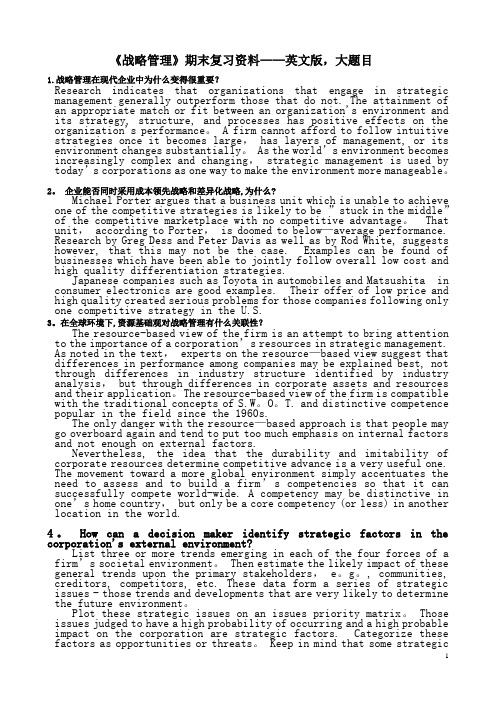
《战略管理》期末复习资料——英文版,大题目1.战略管理在现代企业中为什么变得很重要?Research indicates that organizations that engage in strategic management generally outperform those that do not. The attainment of an appropriate match or fit between an organization's environment and its strategy, structure, and processes has positive effects on the organization's performance。
A firm cannot afford to follow intuitive strategies once it becomes large, has layers of management, or its environment changes substantially。
As the world’s environment becomes increasingly complex and changing, strategic management is used by today’s corporations as one way to make the environment more manageable。
2。
企业能否同时采用成本领先战略和差异化战略,为什么?Michael Porter argues that a business unit which is unable to achieve one of the competitive strategies is likely to be ”stuck in the middle”of the competitive marketplace with no competitive advantage。
《战略管理》期末复习资料-整理完
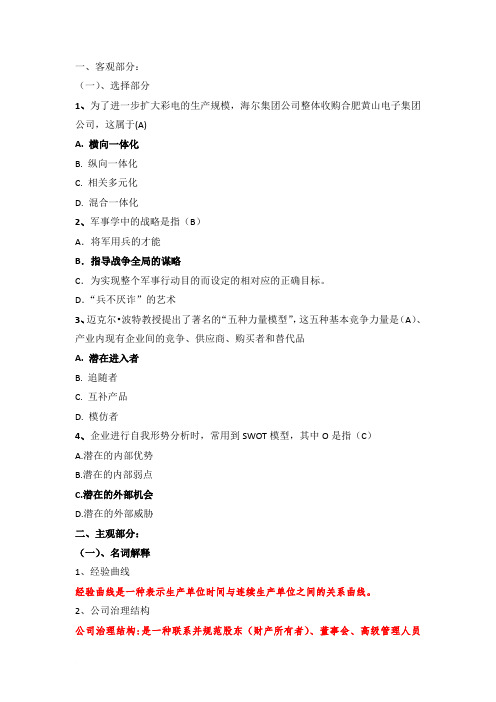
一、客观部分:(一)、选择部分1、为了进一步扩大彩电的生产规模,海尔集团公司整体收购合肥黄山电子集团公司,这属于(A)A. 横向一体化B. 纵向一体化C. 相关多元化D. 混合一体化2、军事学中的战略是指(B)A.将军用兵的才能B.指导战争全局的谋略C.为实现整个军事行动目的而设定的相对应的正确目标。
D.“兵不厌诈”的艺术3、迈克尔•波特教授提出了著名的“五种力量模型”,这五种基本竞争力量是(A)、产业内现有企业间的竞争、供应商、购买者和替代品A. 潜在进入者B. 追随者C. 互补产品D. 模仿者4、企业进行自我形势分析时,常用到SWOT模型,其中O是指(C)A.潜在的内部优势B.潜在的内部弱点C.潜在的外部机会D.潜在的外部威胁二、主观部分:(一)、名词解释1、经验曲线经验曲线是一种表示生产单位时间与连续生产单位之间的关系曲线。
2、公司治理结构公司治理结构:是一种联系并规范股东(财产所有者)、董事会、高级管理人员权利和义务分配,以及与此有关的聘选、监督等问题的制度框架。
3、成本领先战略成本领先战略:也称为低成本战略,是指企业通过有效途径降低成本,使企业的全部成本低于竞争对手的成本,甚至是在同行业中最低的成本,从而获取竞争优势的一种战略。
4、核心能力核心能力:又称核心竞争力,就是能够为企业带来比较优势进而能形成竞争优势的能力和资源。
5、价值链企业的价值创造是通过一系列为基本活动和辅助活动构成的,这些互不相同但又相互关联的生产经营活动,构成了一个创造价值的动态过程,即价值链。
6、规模经济规模经济(economics of scale)又称“规模利益”(scale merit),指随生产能力的扩大,使单位成本下降的趋势,即长期费用曲线呈下降趋势。
7、核心能力是指能使企业长期或持续拥有某种优势的能力,它通常表现为企业经营中的累积性学识,尤其是关于如何协调不同生产技能和有机结合多种技术的学识。
8、标杆学习是一家公司将自己的业绩与一流公司相对比来确定这些公司能达到他们的业绩表现水平,并应用这些信息来改进自己业绩表现的改进的流程。
战略管理期末考试复习题

战略管理期末考试复习题战略管理期末考试复习题战略管理是管理学中的重要分支,它关注企业如何在竞争激烈的市场环境中制定和实施战略,以获得持续竞争优势。
随着全球化和技术进步的推动,战略管理变得愈发重要。
在期末考试中,我们需要对战略管理的各个方面进行复习和理解。
以下是一些常见的战略管理考试题目,希望对大家的复习有所帮助。
1. 什么是战略管理?为什么战略管理对企业至关重要?战略管理是指企业在制定和实施战略时所采取的一系列决策和行动。
它涉及到识别和评估企业内外部环境的机会和威胁,制定长期目标和策略,并通过资源配置和组织协调来实现这些目标。
战略管理对企业至关重要,因为它能够帮助企业在竞争激烈的市场中找到差异化竞争优势,提高企业的绩效和竞争力。
2. 请解释SWOT分析的概念,并说明它在战略管理中的作用。
SWOT分析是指对企业内外环境进行评估的一种方法。
SWOT代表着企业的优势(Strengths)、劣势(Weaknesses)、机会(Opportunities)和威胁(Threats)。
通过SWOT分析,企业可以识别自身的优势和劣势,以及外部环境中的机会和威胁。
这有助于企业制定战略目标和策略,并采取适当的行动来应对竞争和变化。
3. 请描述波特的五力模型,并说明它在战略管理中的应用。
波特的五力模型是指对企业竞争环境进行分析的一种方法。
它包括供应商的议价能力、买家的议价能力、潜在竞争者的威胁、替代品的威胁以及现有竞争者之间的竞争程度。
通过分析这些力量,企业可以了解竞争环境的激烈程度,并制定相应的战略来应对竞争。
4. 请解释价值链分析的概念,并说明它在战略管理中的作用。
价值链分析是指对企业内部活动进行评估的一种方法。
它包括原材料采购、生产、营销、分销等一系列活动。
通过价值链分析,企业可以了解每个环节的价值创造和成本,以及与竞争对手相比的优势和劣势。
这有助于企业确定如何在价值链中创造更多的价值,并提高企业的竞争力。
5. 请解释多元化战略的概念,并说明它的优势和风险。
战略管理期末复习重点

战略管理期末复习重点第一篇:战略管理期末复习重点战略管理P21战略管理的构成要素:1.产品与市场范围(企业正在做什么?未来做什么)2.增长向量3.竞争优势4.协同作用(是衡量企业新产品与市场项目的一种变量)P23-25(掌握)战略管理层次:公司层战略管理,业务层战略管理(内容:如何获得竞争优势),职能层战略管理P46-48明茨伯格的定义/战略的5P模型(单选/多选):1.战略是一种计划(计划在行动之前)2.战略是一种计策(计划在行动之中)3.战略是一种模式(战略是行为的结果)4.战略是一种定位5.战略是一种观念P51企业的宏观环境/掌握PEST模型(多选)行业环境,政治法律环境,经济环境,社会文化环境(人口的分布状况),技术环境 P56-63波特的五力分析法(简答,论述,案例,选择)行业结构中五钟基本的竞争力量:即行业内现有企业间的竞争,潜在的参加竞争者,代替品生产者的威胁,供应商讨价还价的能力,购买者讨价还价的能力P63(掌握)战略环境要素评价模型/外部因素评价(外部,行业关键战略):列出企业的主要机会和威胁一般控制在5~20个P63(掌握)行业关键战略要素评价矩阵(本企业---外部)行业评价矩阵要素可以是外部也可以是内部环境评价模型与行业评价矩阵的异同:一,两者的权重和总加权分数的含义相同二,区别:1.环境评价模型只包括外部关键因素,而行业评价矩阵既包括外部因素也包括内部因素2.行业环境矩阵中的关键因素更为笼统,环境评价模型分为机会和威胁两类3.行业评价矩阵中,竞争公司的评分与总加权分数可以与被分析公司的相应指标进行比较,而战略评价模型是对公司自身的评分P77-79(掌握核心竞争力及其特征)核心竞争力:是能为企业带来相对于竞争对手的竞争优势的资源和能力P77-79核心竞争力的标准(什么是核心能力,他有哪些特征)核心竞争力有四个标准,他们也称做核心竞争的四种战略力量,即有价值的能力,稀有的能力,难以模仿的能力和不可替代的能力核心竞争力都是能力,但不是每一个能力都是核心竞争力。
战略管理复习资料

1、战略就是作战的谋略,也是一种定位。
2、企业战略是根据企业的外部环境及内部资源和能力的状况,为求得企业生存和长期稳定的发展,为不断地获得新的竞争优势,对企业发展目标、达成目标的途径和手段的总体谋划。
3、企业战略的特征: 1、全局性与复杂性2、长远性与风险性3、纲领性与层次性4、稳定性与动态性5、竟争性与合作性4、战略与战术、策略关系:战略与战术是辩证的关系, 战略是方向,一旦方向错了,既使再重视战术(细节)也无济于事。
策略是为战略服务的。
战略:是指企业对达到战略目标的途径和手段的总体谋划。
战术:是指为达到战略目标所采取的具体行动。
联系:战略是战术的灵魂,是战术运用的基础;战术的运用要体现既定的战略思想,是战略的深化和细分。
战术是指解决局部问题的原则和方法,是有关特定军事行动的具体方案,考虑的是如何赢得战斗或战役的胜利。
5、战略管理的特征:1、战略管理具有全局性2、战略管理的主体是企业的高层管理人员3、战略管理涉及企业大量资源的配置问题4、战略管理从时间上来说具有长远性5、战略管理需要考虑企业外部环境中的诸多因素6、战略管理的要素:一、产品与市场范围(是指企业的产品所在的市场和行业)二、增长向量(1、市场渗透2、市场开发3、产品开发4、多种经营)三、竞争优势(比竟争对手的产品有明显优势和差异)四、协同作用7、战略管理的层次:1、总体战略:企业总体战略又称公司层战略,它是企业战略管理的总纲,是企业最高管理层指导和控制整个企业的一切行为的最高行动纲领。
(明确方向、配置资源、决定进退)2、经营单位战略:经营单位战略又称事业部战略,它是企业内部各经营单位在企业总体战略指导下,经营管理每一个特定的经营单位的战略计划。
3、职能战略:职能战略又称职能层战略,是为贯彻、实施和支持总体战略与经营单位战略而在企业特定的职能管理领域制定的战略。
8、战略性思维:战略性思维是指管理者站在公司总体战略设想的高度,来制定决策和实施管理,灵活应付多变的市场环境,給企业带来预期的效益。
企业战略管理期末考试复习

《企业战略管理》期末考试复习资料一、单项选择题(一)1.经典战略理论缺陷之一先忽视了对企业之争环境进行分析与选择,在一定程度上弥补这一缺陷的是()。
A .钱德勒B .安索夫C .波特D .魁恩2.市场渗透战略是由现有产品领域与()组合而成的一种企业成长战略。
A .新产品B .新市场C .现有市场D .现产品3.从战略分析角度看,衰退产业是指在相当长的一段时间里,产业中产品的销售是持续()的产业。
A.上升B .下降C .平稳D .不定4.经验认为,速动比率较为合适的比例是()。
A .1:1B .2:1C .3:2D .1:35.在产品--市场3X3矩阵中,相关产品与相关市场相对应的企业战略类型是()。
A .市场渗透B .多元化C .全方位创新D .市场创造6.纺织印染厂,原来只是将胚布印染成各种颜色的花布供应服装厂,现在纺织印染帮与服装加工厂联合这属于()。
A.前向一体化B .后向一体化C .横向一体化 D .多元化7.企业通过有效途径降低成本,使企业的全部成本低于竞争对手的成本,甚至在同行业中最低的成本,从而在取竞争优势的一种战略是()。
A .低成本战略B .领先战略C .竞争优势战略D .差异化战略8 .美国P&G公司二战后推出“汰涤”洗衣粉获得成功,50年代又推出“快乐”牌,洗衣粉,这种品牌战略是()。
A .多族品牌B .家庭品牌C .个别品牌D .多品牌9.分散化经营单位最适应的经营战略是()A .差异化战略B .集中化战略C .成本经营战略D .市场渗透战略10. 战略与结构关系的基本原则是()A.组织战略服从于组织结构B.组织的结构服从于组织战略C.组织战略与组织结构并列D.产生共同愿景11. 战略管理理论从发展先后顺序来看,大体经过了以环境为基本的经典战略管理理论,以产业结构下物为基础的竞争战略现和以()为基础的核心能力理论三个阶段的演变。
A .科学技术B .资源、知识C .社会、环境D .信息、网络12.现有企业间的竞争是指()各个企业之间的竞争关系和程度。
战略管理期末重点

1、战略:作战的谋略,最初多应用于军事领域,现在除军事领域外,战略正越来越多被应用于政治、经济、文化、教育等领域。
在管理学中,战略是指组织对有关全局性、长远性、纲领性目标的谋划和决策。
企业战賂是指企业为适应未来环境的变化,对生产经营和持续、稳定发展中的全局性、长远性、纲领性目标的谋划和决策.2、企业战略管理是对制定、实施、评估、调控和变革企业战略的全部活动的总称。
包含四个主要阶段:战略分析阶段、战略选择阶段、战略实施阶段、战略控制阶段。
3、战略管理理论从发展的先后顺序看,大体上经过了如下三个阶段的演变:60、70年代(钱德勒):以环境为基点的经典战略管理理论;扩展:分析了环境、战略和组织结构之间的相互关系。
他认为•企业经营战略应当适应环境“ 满足市场需要,而组织结构又必须适应企业战略,随着战略变化而变化.80年代:(波特):以产业(市场)结构分析为基础的竞争战略理论:扩展:波特认为,企业盈利能力取决于英选择何种竞争战略,而竞争战略的选择应基于以下两点考虑:(1)选择有吸引力的、高潜在利润的产业;(2)在已选择的产业中确定自己优势的竞争地位。
与经典战略理论相比,竞争战略理论前进了一大步。
它指出了企业在分析产业(市场)结构竞争环境的基础上制定竞争战略的重要性,从而有助于企业将其竞争战略的眼光转向对有吸引力的产业的选择上.9 0年代早期:以资源、知识为基础的核心竞争力理论。
扩展:该理论认为,企业经营战略的关键在于培养和发展企业的核心竞争力(只有当资源、知识和能力同时符合珍贵、异质、不可模仿、难以替代的标准)。
所谓核心竞争力是“组织中的积累性学识,特别是关于如何协调不同的生产技能和有机结合多种技术流的学识"。
4、公司战略制定的层次一、公司层战略:从全公司高度,管理一组业务的策略计划:如何建立竞争地位、如何多元化(由CEO和其他高层执行官制建)二、业务层战略(针对公司的每项业务):加强每种业务市场地位,构筑竞争优势如:液体奶、奶粉(由公司负责不同业务线的普通经理制立,在每个业务范围内还常常有来自职能领域活动的领导者建议和意见)三、每个业务内部的职能层战略:如:产品开发战略、营销战略、人才战略、技术战略(由某个业务内部主要职能活动的领导者制定)四、每个业务内部的经营战略:各经营单位的战略,如工厂、分销中心、地理区域等(由品牌经理、工厂、分销公司的执行经理,以及战略上的重要的活动的经理制左)补充:在一个单一业务的公司中,此两个层次合并成公司业务战略5、企业战略的构成要素错谋!产品市场界定(P roduc t 一Mar ket Sco pe)界左企业到底属于哪一个产业,以泄出本身的产品和市场的属性,同时也界泄了潜在的竞争者。
2024年《企业战略管理》期末考试复习题库(含答案)

2024年《企业战略管理》期末考试复习题库(含答案)一、单选题1.当今世界上竞争战略和竞争力方面公认的第一权威是A、安索夫B,钱德勒G德鲁克D、迈克尔•波特答案:D2-根据对企业经营影响的远近,企业外部环境因素通常被划分为三个层次,其中不包括Ax宏观环境B、微观环境C、市场与行业环境0、竞争与合作环境答案:B3.企业关于未来需要努力实现目的的一种可以精确测量的描述称为A、战略目标B、战略预期Cx战略设想D4战略规划4.属于企业声誉资源的是A、商标B,专利G版权Dv质量标准答案:A5,提出权变理论的战略学派是A、计划学派B、设计学派Cv环境学派D4定位学派答案:C6.战略最基本的内涵是A、战略是一种定位B4战略是一种模式C、战略是一种计划D4战略是一种愿景答案:C7.企业在竞争互动中具有相互矛盾作用的因素是B4规模C4速度D、创新答案:B8.属于稳定型战略的是A、多元化战略B4一体化战略C4谨慎实施战略D4剥离战略答案:C9.某些产业政策和针对特定商务活动的政府干预所带来的企业国际化风险属于Ax财务风险B4经营风险C4经济风险D、政治风险答案:D10.在同一产业链中,处于价值年相同环节上企业间的并购称为A、纵向并购横向并购C4混合并购D4杠杆并购答案:B11.提出计划学派大多数假定的著作是A、安索夫的《企业战略》22.协同效应战略联盟属于A'公司层战略联盟B、业务层战略联盟C4事业层战略联盟D、职能层战略联盟答案:A23.企业的战略目标通常是A4短期的目标B4宏观的目标C、单一性目标D4定量目标答案:B24.全球价值链的概念源于A、波特G德鲁克D、安索夫答案:A25.一般来说.在行业或市场生命周期的后期增长阶段,发挥竞争优势的主要目的是A.提高产品的研发能力B4巩固垄断地位C4迅速扩大生产D4提高市场占有率答案:A26.新兴的企业国际化动因是A、寻求资源Bs学习C4寻求市场D、寻求效率答案:B27.发挥优势减少威胁的应对策略势是A4So策略ST策略DxWT策略答案:B28.20世纪50年代,行业多元化发展的热潮出现在Av英国B'美国C4德国Ds日本答案:B29.届于企业宏观环境中经济环境因素的是4.按照产业组织模式的逻辑战略管理制定的基本步骤。
战略管理复习资料
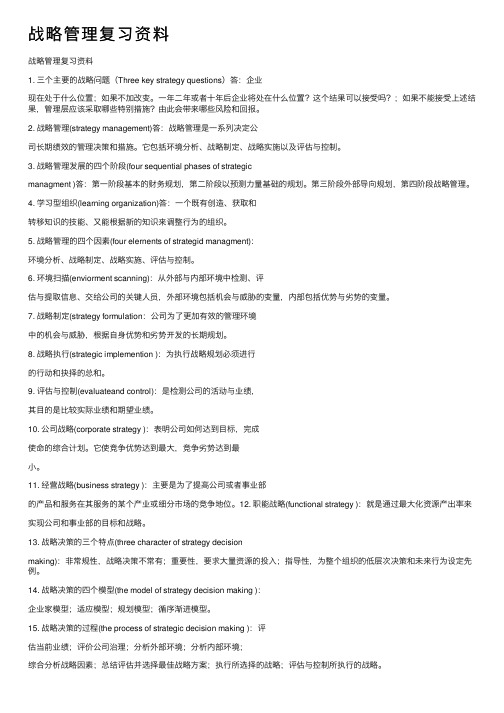
战略管理复习资料战略管理复习资料1. 三个主要的战略问题(Three key strategy questions)答:企业现在处于什么位置;如果不加改变。
⼀年⼆年或者⼗年后企业将处在什么位置?这个结果可以接受吗?;如果不能接受上述结果,管理层应该采取哪些特别措施?由此会带来哪些风险和回报。
2. 战略管理(strategy management)答:战略管理是⼀系列决定公司长期绩效的管理决策和措施。
它包括环境分析、战略制定、战略实施以及评估与控制。
3. 战略管理发展的四个阶段(four sequential phases of strategicmanagment )答:第⼀阶段基本的财务规划,第⼆阶段以预测⼒量基础的规划。
第三阶段外部导向规划,第四阶段战略管理。
4. 学习型组织(learning organization)答:⼀个既有创造、获取和转移知识的技能、⼜能根据新的知识来调整⾏为的组织。
5. 战略管理的四个因素(four elernents of strategid managment):环境分析、战略制定、战略实施、评估与控制。
6. 环境扫描(enviorment scanning):从外部与内部环境中检测、评估与提取信息、交给公司的关键⼈员,外部环境包括机会与威胁的变量,内部包括优势与劣势的变量。
7. 战略制定(strategy formulation:公司为了更加有效的管理环境中的机会与威胁,根据⾃⾝优势和劣势开发的长期规划。
8. 战略执⾏(strategic implemention ):为执⾏战略规划必须进⾏的⾏动和抉择的总和。
9. 评估与控制(evaluateand control):是检测公司的活动与业绩,其⽬的是⽐较实际业绩和期望业绩。
10. 公司战略(corporate strategy ):表明公司如何达到⽬标,完成使命的综合计划。
它使竞争优势达到最⼤,竞争劣势达到最⼩。
战略管理 期末考试重点汇总
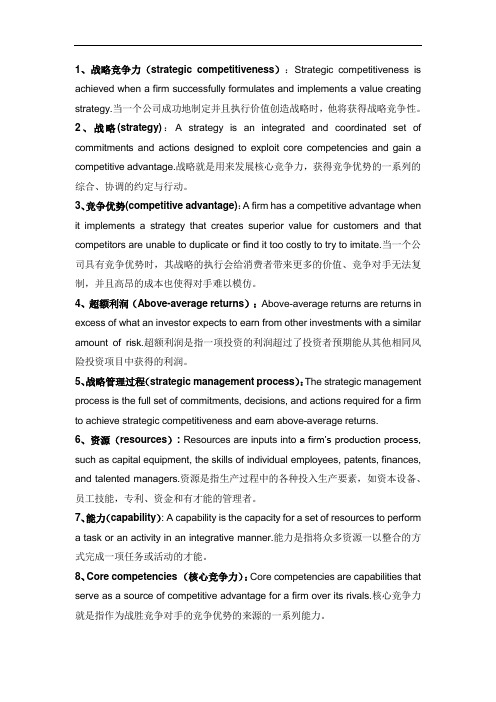
1、战略竞争力(strategic competitiveness):Strategic competitiveness is achieved when a firm successfully formulates and implements a value creating strategy.当一个公司成功地制定并且执行价值创造战略时,他将获得战略竞争性。
2、战略(strategy):A strategy is an integrated and coordinated set of commitments and actions designed to exploit core competencies and gain a competitive advantage.战略就是用来发展核心竞争力,获得竞争优势的一系列的综合、协调的约定与行动。
3、竞争优势(competitive advantage):A firm has a competitive advantage when it implements a strategy that creates superior value for customers and that competitors are unable to duplicate or find it too costly to try to imitate.当一个公司具有竞争优势时,其战略的执行会给消费者带来更多的价值、竞争对手无法复制,并且高昂的成本也使得对手难以模仿。
4、超额利润(Above-average returns):Above-average returns are returns in excess of what an investor expects to earn from other investments with a similar amount of risk.超额利润是指一项投资的利润超过了投资者预期能从其他相同风险投资项目中获得的利润。
《战略管理》期末复习资料
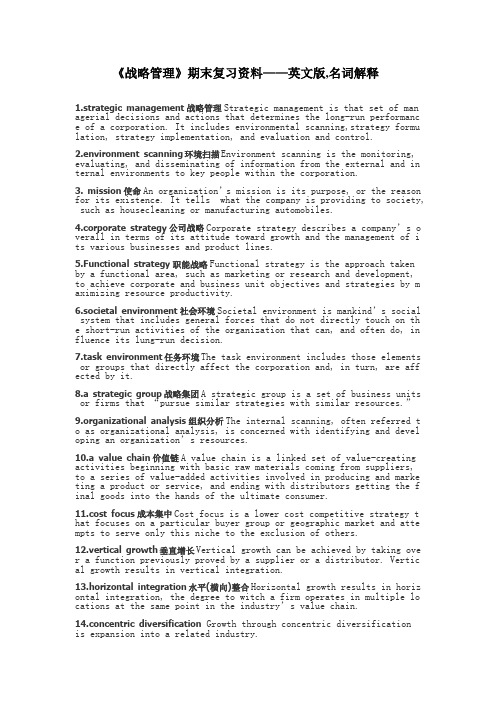
《战略管理》期末复习资料——英文版,名词解释1.strategic management战略管理Strategic management is that set of man agerial decisions and actions that determines the long-run performanc e of a corporation. It includes environmental scanning,strategy formu lation, strategy implementation, and evaluation and control.2.environment scanning环境扫描Environment scanning is the monitoring, evaluating, and disseminating of information from the external and in ternal environments to key people within the corporation.3. mission使命An organization’s m ission is its purpose, or the reason for its existence. It tells what the company is providing to society, such as housecleaning or manufacturing automobiles.4.corporate strategy公司战略Corporate strategy describes a company’s o verall in terms of its attitude toward growth and the management of i ts various businesses and product lines.5.Functional strategy职能战略Functional strategy is the approach taken by a functional area, such as marketing or research and development, to achieve corporate and business unit objectives and strategies by m aximizing resource productivity.6.societal environment社会环境Societal environment is mankind’s social system that includes general forces that do not directly touch on th e short-run activities of the organization that can, and often do, in fluence its lung-run decision.7.task environment任务环境The task environment includes those elements or groups that directly affect the corporation and, in turn, are aff ected by it.8.a strategic group战略集团A strategic group is a set of business units or firms that “pursue similar strategies with similar resources.”anizational analysis组织分析The internal scanning, often referred t o as organizational analysis, is concerned with identifying and devel oping an organization’s resources.10.a value chain价值链A value chain is a linked set of value-creating activities beginning with basic raw materials coming from suppliers, to a series of value-added activities involved in producing and marke ting a product or service, and ending with distributors getting the f inal goods into the hands of the ultimate consumer.11.cost focus成本集中Cost focus is a lower cost competitive strategy t hat focuses on a particular buyer group or geographic market and atte mpts to serve only this niche to the exclusion of others.12.vertical growth垂直增长Vertical growth can be achieved by taking ove r a function previously proved by a supplier or a distributor. Vertic al growth results in vertical integration.13.horizontal integration水平(横向)整合Horizontal growth results in horiz ontal integration, the degree to witch a firm operates in multiple lo cations at the same point in the industry’s value chain.14.concentric diversification Growth through concentric diversification is expansion into a related industry.15.a profit strategy利润战略A profit strategy is a decision to do nothi ng new in a worsening situation, but instead to act as though the com pany’s problems are only temporary.。
最新战略管理期末考试重点知识总结

第一章战略管理和竞争力2、描述竞争格局,解释全球化和技术变革对竞争格局的影响。
全球经济的出现,以及经济和技术的快速变化所导致的全球一体化,是形成当前激烈竞争格局的主要原因。
人们常用“超级竞争”一词,来描述竞争格局的现状。
在超级竞争条件下,市场稳定性的假设对市场固有的不稳定性和变化取代。
全球经济的出现,技术的飞速进步,是导致当前的超级竞争环境和竞争格局的两个主要原因。
全球经济是指商品、服务、人员、技术和观念超越地理界线自由流通。
全球化为公司在当前格局下的竞争提供了更多的机会。
总而言之,全球化已经对多个竞争维度提出了更高的业绩评估标准,包括质量,成本,产量,产品上市时间运营效率等,公司能否意识到这一点是至关重要的。
虽然全球化给公司带来了潜在的利益,但同时也带来了风险。
总的来说,公司在其本国之外经营,因对异国的文化、习俗和法律等不熟悉所存在的风险以及全球经济的风险都被贴上了“异国的责任”的标签。
公司需要时间来学习如何在这个全新的市场上进行竞争。
另外公司的业绩也会受到大规模全球化进程的影响。
技术的现状和发展趋势,可以分为三类:技术扩散和突破性技术、信息时代、不断增加的知识密度。
当技术的传播与扩散使得产品同质化时,或许只有新产品的开发速度才是获得竞争优势的主要来源。
技术的扩散速度降低了专利的竞争优势。
突破性技术是指能够摧毁原有技术并创造新市场的技术。
虽然一项突破性的技术可以创造出一个新的产业,但同时它也会损害原有产业中的公司。
原有产业中的公司可以在优势资源和经验的基础上进行调整,并借助多元化手段来获取新技术。
在目前的竞争格局下,信息技术的成本不断下降,信息的获取更加便利。
低价计算机的增加机器通过计算机网络的相互联系,进一步加快了信息技术的发展和扩散。
因此,在全世界,包括新兴经济体,任何公司都可以获得信息技术的潜在竞争力。
知识是通过经验观察和推理得到的一种无形资源。
进行创新必须拥有牢固的知识基础。
知识外溢的潜在性使公司必须迅速将知识应用于生产领域。
战略管理期末复习重点
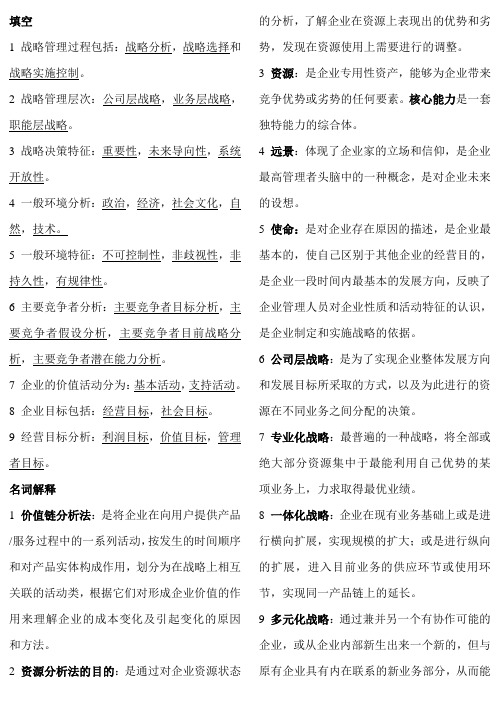
填空1 战略管理过程包括:战略分析,战略选择和战略实施控制。
2 战略管理层次:公司层战略,业务层战略,职能层战略。
3 战略决策特征:重要性,未来导向性,系统开放性。
4 一般环境分析:政治,经济,社会文化,自然,技术。
5 一般环境特征:不可控制性,非歧视性,非持久性,有规律性。
6 主要竞争者分析:主要竞争者目标分析,主要竞争者假设分析,主要竞争者目前战略分析,主要竞争者潜在能力分析。
7 企业的价值活动分为:基本活动,支持活动。
8 企业目标包括:经营目标,社会目标。
9 经营目标分析:利润目标,价值目标,管理者目标。
名词解释1 价值链分析法:是将企业在向用户提供产品/服务过程中的一系列活动,按发生的时间顺序和对产品实体构成作用,划分为在战略上相互关联的活动类,根据它们对形成企业价值的作用来理解企业的成本变化及引起变化的原因和方法。
2 资源分析法的目的:是通过对企业资源状态的分析,了解企业在资源上表现出的优势和劣势,发现在资源使用上需要进行的调整。
3资源:是企业专用性资产,能够为企业带来竞争优势或劣势的任何要素。
核心能力是一套独特能力的综合体。
4 远景:体现了企业家的立场和信仰,是企业最高管理者头脑中的一种概念,是对企业未来的设想。
5 使命:是对企业存在原因的描述,是企业最基本的,使自己区别于其他企业的经营目的,是企业一段时间内最基本的发展方向,反映了企业管理人员对企业性质和活动特征的认识,是企业制定和实施战略的依据。
6 公司层战略:是为了实现企业整体发展方向和发展目标所采取的方式,以及为此进行的资源在不同业务之间分配的决策。
7 专业化战略:最普遍的一种战略,将全部或绝大部分资源集中于最能利用自己优势的某项业务上,力求取得最优业绩。
8 一体化战略:企业在现有业务基础上或是进行横向扩展,实现规模的扩大;或是进行纵向的扩展,进入目前业务的供应环节或使用环节,实现同一产品链上的延长。
9 多元化战略:通过兼并另一个有协作可能的企业,或从企业内部新生出来一个新的,但与原有企业具有内在联系的新业务部分,从而能更好的发挥新老业务的优势。
- 1、下载文档前请自行甄别文档内容的完整性,平台不提供额外的编辑、内容补充、找答案等附加服务。
- 2、"仅部分预览"的文档,不可在线预览部分如存在完整性等问题,可反馈申请退款(可完整预览的文档不适用该条件!)。
- 3、如文档侵犯您的权益,请联系客服反馈,我们会尽快为您处理(人工客服工作时间:9:00-18:30)。
精品文档《战略管理》期末复习资料——英文版,大题目1.战略管理在现代企业中为什么变得很重要?Research indicates that organizations that engage in strategic management generally outperform those that do not. The attainment of an appropriate match or fit between an organization's environment and its strategy, structure, and processes has positive effects on the organization's performance. A firm cannot afford to follow intuitive strategies once it becomes large, has layers of management, or its environment changes substantially. As the world's environment becomes increasingly complex and changing, strategic management is used by today's corporations as one way to make the environment more manageable.2. 企业能否同时采用成本领先战略和差异化战略,为什么?Michael Porter argues that a business unit which is unable to achieve one of the competitive strategies is likely to be "stuck in the middle" of the competitive marketplace with no competitive advantage. That unit, according to Porter, is doomed to below-average performance. Research by Greg Dess and Peter Davis as well as by Rod White, suggests however, that this may not be the case. Examples can be found of businesses which have been able to jointly follow overall low cost and high quality differentiation strategies.Japanese companies such as Toyota in automobiles and Matsushita in consumer electronics are good examples. Their offer of low price and high quality created serious problems for those companies following only one competitive strategy in the U.S.3.在全球环境下,资源基础观对战略管理有什么关联性?The resource-based view of the firm is an attempt to bring attention to the importance of a corporation's resources in strategic management. As noted in the text, experts on the resource-based view suggest that differences in performance among companies may be explained best, not through differences in industry structure identified by industry analysis, but through differences in corporate assets and resources and their application. The resource-based view of the firm is compatible with the traditional concepts of S.W.O.T. and distinctive competence popular in the field since the 1960s.The only danger with the resource-based approach is that people may go overboard again and tend to put too much emphasis on internal factors and not enough on external factors.Nevertheless, the idea that the durability and imitability of corporate resources determine competitive advance is a very useful one. The movement toward a more global environment simply accentuates the need to assess and to build a firm’s competencies so that it can successfully compete world-wide. A competency may be distinctive in one’s home country, but only be a core competency (or less) in another location in the world.4. How can a decision maker identify strategic factors in the corporation's external environment?List three or more trends emerging in each of the four forces of a firm's societal environment. Then estimate the likely impact of these general trends upon the primary stakeholders, e.g., communities, creditors, competitors, etc. These data form a series of strategic issues - those trends and developments that are very likely to determine the future environment.Plot these strategic issues on an issues priority matrix. Those issues judged to have a high probability of occurring and a high probable impact on the corporation are strategic factors. Categorize these精品文档factors as opportunities or threats. Keep in mind that some strategic factors may be both opportunities and threats depending upon how one views them.5.企业制定战略需要什么信息,为什么?In order to properly formulate strategy, it is essential to have information on the important variables in both the external and internal environments of the corporation. This includes general forces in the societal environment as well as the more easy-to-identify groups such as customers and competitors in the task environment. A corporation needs to have this information in order to identify a need it can fulfill via its corporate mission.It is also important to have information on the corporation's structure, culture, and resources. A corporation needs to have this information in order to assess its capabilities to satisfy a customer's need by making and/or distributing a product or service. Information on both the internal and external environments can also help a corporation to predict likely opportunities and threats. Long-term strategies can be designed with these in mind.6. 为了获得竞争力,企业是将资源放在核心竞争力上还是在减少劣势上?This is one of the toughest questions in strategic management. Unfortunately, there is no one best answer to this question. Most of the literature in strategy does not even deal with this issue, yet it is a crucial one.The heavy emphasis on building distinctive competencies in the literature seems to assume that the company has no significant weaknesses. A weakness, in itself, is not a problem unless it prevents the company from successfully implementing its strategy. One solution to this question is to argue that a company must do both: build distinctive competencies and eliminate core weaknesses. However, if there is insufficient money to do both, what then? If the weakness is an obstacle to effective strategy implementation, either the weakness must be fixed or the strategy changed. This should be a good discussion question - especially for grad students.7. Why are strategic decisions different from other types of decisions?Strategic decisions deal with the long-run future of the entire organization and have three characteristics which differentiate them from other types of decisions:(1)They are rare. Strategic decisions are unusual and typically have no precedent to follow;(2)They are consequential. Strategic decisions commit substantial resources and demand a great deal of commitment;(3)They are directive. Strategic decisions set precedents for lesser decisions and future actions throughout the organization.8.公司战略管理是怎样演化的Strategic management within a firm generally evolves through four seguential phases of developmentphase1:Basic financial planningphase2:Forecast-based planningphase3:Externally oriented strategic planningphase4:Strategic management9.描述价值链并说明价值链分析怎样帮助企业获得竞争优势?A value chain is a linked set of value-creating activities beginning with basic raw materials coming from suppliers, to a series of value-added activities involved in producing and marketing a product or service, and ending with distributors getting the final goods into the hands of the ultimate consumer.The systematic examination of individual value activities can lead to精品文档a better understanding of a corporation’strengths and weaknesses-thus identifying any core or distinctive competencies.According to Porter,“Differences among competitor value chains are a key source of competitive advantage.”.10.社会环境的力量,五力模型Societal environment is mankind’s social system that includes gene ral forces that do not directly touch on the short-run activities ofthe organization that can, and often do, influence its lung-run dec ision.(1)E conomic forces,T echnological f orces,P olitical-legal forces ,S ociocultural forces(2)Threat of new entrants、Rivalry among existing firms、Threat of substitute products、Bargaining power of buyers、Bargaining power of suppliers11.当企业变得超竞争时,保持可持续的竞争优势是否有可能?In his book Hypercompetition, D’Aveni proposes that it is becoming increasingly difficult to sustain a competitive advantage for very long. Consequently, a company or business unit must constantly work to improve its competitive advantage or else it will not be sustainable.It is not enough to be just the lowest cost competitor. Through continuous improvement programs, competitors are usually working to lower their costs as well. Firms must find new ways not only to reduce costs further, but also to add value to the product or service being provided. The same is true of a firm or unit that is following a differentiation strategy.According to D'Aveni, companies in a hypercompetitive industry learn to quickly imitate the successful strategies of market leaders - making it increasingly difficult to sustain any competitive advantage. Competitive advantage in a hypercompetitive industry comes from an up-to-date knowledge of environmental trends and competitive activity coupled with a willingness to risk a current advantage for a possible new advantage. Companies must thus be willing to cannibalize their own successful products in order to sustain their competitive advantage. Since hypercompetitive industries go through escalating stages of competition, the only real sustainable competitive advantage lies not in a corporation's product line, but in its ability to learn and to adapt to constantly changing conditions.12. 什么时候战略决策时,规划模式要比企业家模式和适应性模式要优越?The planning mode is generally superior to the entrepreneurial and adaptive modes when the organization is fairly large, when knowledge is spread throughout the organization, and when the organization has at least a moderate amount of time to engage in strategic planning.The book proposes that the planning mode is more rational and thus a better way of making most strategic decisions than are the other modes. It may not, however, always be possible. The entrepreneurial mode can be very useful when time is short, one person or group is able to grasp the essentials of the business and its environment, and that person or group is able to influence the rest of the organization to accept the strategic decision. The adaptive mode is generally not considered to be very effective in most situations, but seems to be the fallback mode when entrepreneurial or planning modes can't operate effectively because of political infighting or lethargy. It is a typical mode in not-for-profit organizations.13. 对比S.W.O.T 分析和投资组合分析These two approaches are alike in a number of ways. They are both attempts to summarize the key strategic factors coming out of an in-depth analysis of the external and internal environment of a corporation or business unit. They are also easy to remember buzz-words for use in the situational analysis. Terms like S.W.O.T., cash cows, and dogs help remind the student that the basis of strategic management is environmental assessment.They are different in terms of what they stand for. SWOT is merely an acronym for S trengths, W eaknesses, O pportunities, and T hreats. It is not really a technique to aid in situation analysis. It merely is a buzz-word to help a person remember to search for strategic variables. Portfolio analysis, in contrast, is a term for a whole series of different techniques for analyzing internal and external environmental factors. Neither is really a substitute for the other and can actually complement each other.14. 战略的层次性The hierarchy of strategy is a term used to describe the interrelationships among the three levels of strategy (c orporate, b usiness, and f unctional) typically foundin large business corporations.Beginning with the corporate level, each level of strategy forms the strategic environment of the next level in the corporation. This means that corporate level objectives, strategies, and policies form a key part of the environment of a divisionor business unit. The objectives, strategies, and policies of the division or unit must therefore be formulated so as to help achieve the plans of the corporate level. The same is true of functional departments which must operate within the objectives, strategies, and policies of a division or unit.15. 根据波特的行业分析,百事可乐是可口可乐的替代品吗?According to Porter, substitute products are those products that appear to be different but can satisfy the same need as another product. The identificationof possible substitute products or services means searching for products or services that can perform the same function, even though they may not appear to be easily substitutable. Pepsi and Coke are, therefore, not substitutes for each other. They are merely different brands of the same cola product. The real question here is: what is the product? If the product is colas, then a lemon-lime drink like Seven Up could be a substitute product. If the product is carbonated soft drinks, then other beverages which might perform the same function could be identified, such as coffee, tea, beer, wine, or Kool Aid.16. 作为公司战略,水平增长不同于垂直增长的地方是? From concentric diversification?Horizontal growth is the expanding of firm's activities into other geographic regions and/or by increasing the range of products and services offered to current markets. It often involves the acquisition of another firm in the same industry, but it could also be through the expansion of a firm's products in its current markets or expansion into another geographic region .Vertical growth, in contrast, involves a firm's taking over a function previously performed by a supplier or a distributor. This would typically involve the addition of activities in other industries either forward or backward on the value chain of current products or services. The additions are primary justified in terms of support of the current product lines regardless of their being in other industries.Concentric diversification, in contrast, is the addition of products or divisions which are related to the corporation's main business, but are added because of the attractiveness of other industries rather than because they support the activities of the current product lines. The additions may be through acquisition or through internal development. The firm buys or develops another division which is similar to its present product-line. The products are not alike, but have a "common thread" relating them.If Coca Cola bought RC Cola, it would be an example of horizontal integration. If it purchased its distributors, this would be an example of forward vertical integration. Its acquisition of Taylor Wines, however, was an example of concentric diversification.。
